

 |
||
 |
||
Vol. 12 (1): June 2009 |
||
Croatia / Greece / Italy / Mauritania & Western Sahara / Spain / Turkey
Spain
|
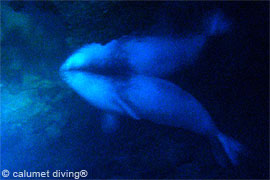 |
|
|
The Isla del Toro sighting, June 2008. |
Coastal survey research funded by the Balearic Islands government has located 35 caves in the area where a solitary monk seal was seen last summer, according to press reports and other sources in Mallorca. The species made its surprise reappearance after a fifty-year absence, following the killing of the last remaining individual in the late 1950s. The government is now set to install automatic cameras in identified caves to monitor presence by seals. A test installation has already been completed.
Medio Ambiente instalará cámaras submarinas para controlar al ´vell marí´, Diario de Mallorca, 7 January 2009.
Detectan 35 cuevas que podrían ser refugio del ‘vell marí’. terra.es, 2 January 2009.
Seal returns after 50-year absence, TMG 11 (2): November 2008.
Our thanks to Toni Vecina of Mallorca for help in compiling this publications list.
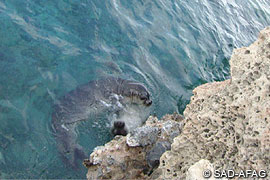 |
|
|
Monk seals on the northern coast of the Datça Peninsula. |
Multiple monk seal sightings were reported to SAD-AFAG in the 2008-2009 winter/spring period, backed by photographic or video evidence obtained by locals, including fishermen, dive guides and journalists. On the northern coasts of the Datça Peninsula, four seals were observed and filmed along the rocky shores near a sea cave, including an adult female, a subadult and a juvenile.
Two monk seals were observed and photographed near Bodrum, just 100 meters from the harbour. Elsewhere, two adult monk seals were photographed and filmed underwater near Akkuyu, Mersin, by divers. The images from Mersin also revealed that one of the seals had become entangled at the hind-flippers by “ghost” net fragments, hindering its movement. These various data were stored in the SAD-AFAG database and will hopefully assist the Turkish authorities in making better management and conservation decisions on the species and its habitat in the country. – Cem O. Kıraç and Harun Güçlüsoy, SAD-AFAG.
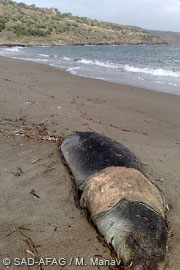 |
|
|
Juvenile monk seal found dead near Behramkale, Çanakkale. |
SAD-AFAG has received several recent reports of monk seal deaths through its AFBIKA Project, a national monk seal strandings network launched in 2003. Firstly, a juvenile monk seal was found dead near Behramkale, Çanakkale, in February 2009 by free-diving speargun fishermen who also happen to be AFAG supporters. An external examination did not reveal any clear evidence of gunshot wounds.
On 7 April 2009, the discovery of a dead monk seal was reported to SAD-AFAG’s Ankara head office from the island of Çatalada, off Turgutreis. The assistance of the Coast Guard, which cooperates with SAD-AFAG in the AFBIKA Project, was requested and quickly granted, with the local command providing transport to the island by inflatable.
Following initial examination of the carcass on site, resident vet Fulya Massozzi, a SAD-AFAG volunteer, conducted the necropsy in Yalikavak.
The cause of death could not be clearly identified. However, as a result of the necropsy, it was observed that the monk seal was an adult male; that it had died at least 15-20 days earlier; that the corpse was heavily decomposed; that approximately 30 very small (2mm diameter) shots were found in its fatty tissues; and that two of the left ribs were broken. The possibility that the seal might have been killed – or had died – in the area where it was found was taken into consideration; as was the possibility that it had died elsewhere and had drifted in to Çatalada on the current.
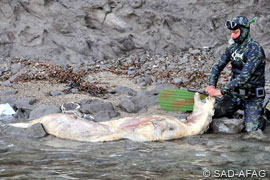 |
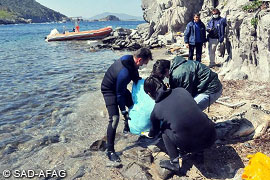 |
|
|
Adult monk seal found dead on Çatalada. |
On site investigation by SAD-AFAG, Turkish Coast Guard and local fishermen. |
All the findings and information were entered into the FokData database of SAD-AFAG. – Cem O. Kıraç and Harun Güçlüsoy, SAD-AFAG.
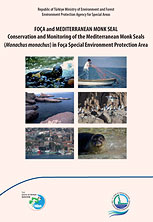 |
|
|
|
A new publication on Foça and the monk seal has been prepared by SAD-AFAG, and published by EPASA, the Environment Protection Agency for Special Areas.
This publication underlines the importance of Mediterranean monk seals as one of the rarest animals in the world, and as symbolising a need for protection of the marine and coastal ecosystems as a whole. The book presents a comprehensive assessment on the species, as well as its habitats and the threats it faces within the Foça area. It also compares the past and current status of monk seals and habitats in the Foça SEPA (Special Environment Protection Area), and presents an analysis of problems and further measures to be taken for the protection of the species and its habitat in the area. – Elif Tertemiz, SAD-AFAG.
Kırac, C. O. and H. Güçlüsoy. 2008. Foça and Mediterranean Monk Seal; Conservation and Monitoring of the Mediterranean Monk Seals (Monachus monachus) in Foca Special Environment Protection Area. EPASA Publications. December 2008, Ankara: 1-48 [PDF  2.1MB].
2.1MB].
 |
|
|
“Boncuk Bay” in Gökova Bay, one of the very rare breeding grounds of sand-bar sharks in the Mediterranean, where the species migrates to breed. |
Gökova Bay, formed by the Bodrum and Datça Peninsulas, represents an important monk seal habitat in Turkey. In the beginning of January work commenced on the Integrated Coastal and Marine Management Planning Project, whose activities are designed to directly or indirectly benefit the species in the area.
Data on artisanal and industrial fisheries, fishery socio-economics, sand-bar sharks, marine and wetland avifauna are being collected. A study of new legislation in line with the EU Common Fisheries Policy has also begun, aimed at better management of Gökova SEPA. While these elements of the project were on-going, a survey on the monk seal and coastal habitat was being planned for July and October 2009. By the end of the project, an integrated coastal and marine management (ICMM) planning proposal will be produced through GIS work in cooperation with SAD-AFAG, Stichting Rubicon, EPASA, the Ministry of Agriculture and several local stakeholders. In order to cover protection of endangered species in the area, including the monk seal, the ICMM incorporates a holistic approach in its activities. – N. Ozan Veryeri, SAD-AFAG.
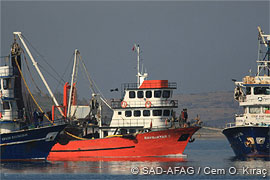 |
|
|
New regulations are expected to limit the impact of boat traffic within the Foça SEPA. |
In May 2008, the Environment Protection Agency for Special Areas (EPASA) nominated SAD-AFAG to carry out two research and analysis projects in the Foça Special Environment Protection Area (SEPA): Marine Vessel Carrying Capacity of Foça SEPA and Monitoring of the Mediterranean Monk Seal and its Habitat in Foça SEPA.
This project was finalised in December 2008, and provided significant data for the management plan of the Foça SEPA. The most important outcome of the project was the finding that boat harbouring carrying capacity in the area had reached maximum capacity. The future management plan will regulate pollution originating from these vessels as well as disturbance created to monk seals and other biota; proposed rules and implementation procedures will also be incorporated. EPASA expects to finalise the management planning of Foça SEPA in cooperation with SAD-AFAG and local stakeholders by the end of this year. – Elif Tertemiz and Gökhan Kaboğlu, SAD-AFAG.
An infected eye giving cause for concern, monk seal ‘Badem’ underwent a veterinary examination and in situ treatment on the Datça Peninsula, Turkey, on 5 January. Antibiotic drops were applied, and although the treatment was repeated two days later when Badem was discovered sleeping in a boat, the full course could not be completed as the seal strayed from the area and could not be located for the following three weeks, despite efforts by SAD-AFAG and attending veterinarians to do so.
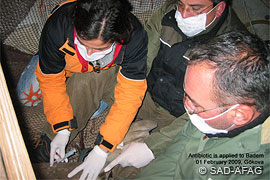 |
|
|
Antibiotic administered to Badem at Gökova Bay, 1 February, 2009. |
Despite the infection, Badem was judged to be in good overall health.
The injury was apparently sustained following her reported raid on fish farms in Bozburun, though both SAD-AFAG and its consulting veterinarians found suggestions unlikely that the seal might have been deliberately harmed.
On 30 January, following another fruitless search of the Mesudiye-Datça area by AFAG’s Ozan Veryeri and SAD-AFAG representative Sezer Çete, Badem was finally found in Hisarönü near Bozburun.
Following an onsite examination by veterinarians Avni Gök and Fulya Massizzo, which indicated that the eye remained infected, it was decided to bring Badem again into semi-captivity, and to the specially-designed pen in Gökova Bay, where she had previously been held during the tourist season, because of her boisterous interactions with swimmers and beach-goers.
The specially designed sea pool measures 50m x 50m, and is 22m in depth, with a total surface area of 2500m2.
There, the seal was put under the care of veterinarians Avni Gök and Fulya Massizzo, who determined that the eye injury was not acute, and that Badem would soon be re-released.
Quoted in the Turkish daily Hurriyet, Fulya Massizzo emphasised that the injury had most likely been sustained at sea, possibly while Badem was foraging for food. A sharp object, it was suggested, natural or manmade, may have pierced the eye.
The Seal Rehabilitation and Research Centre (SRRC) Lenie ‘t Hart of Pieterburen, the Netherlands, meanwhile, had recommended a veterinary treatment previously applied to a monk seal pup in the Northern Sporades Marine Park in Greece [see The in situ treatment of a Mediterranean monk seal pup at Piperi Island, 11 (2): November 2008]. The pup had sustained a similar eye injury and was treated with a long-acting antibiotic administered subcutaneously.
The same treatment was subsequently administered to Badem, the veterinarians reporting that the seal was in good health and displaying no abnormal behaviour. Her reaction to the antibiotic would be closely monitored.
At the same time, AFAG representatives have suggested that Badem may at last be regaining some of her wild nature, but again cautioned that members of the public should help the seal along in that transition by not interacting with her.
AFAG states that the apparent change in Badem’s behaviour was first noted after December 2008, and that she has now started to shy away from human contact. While Badem would previously gravitate towards beaches, says AFAG, since December she has tended to rest in moored inflatable boats, keeping her distance from the coast.
Rescued in December 2006 as an orphaned pup, Badem underwent rehabilitation in Foça, with AFAG drawing on expertise and nursing skills provided by the Zeehondencrèche Lenie ‘t Hart of the Netherlands. Regrettably, the seal became imprinted on her human carers during the 5-month process, a condition later exacerbated by swimmers’ and beachgoers’ demands for contact with her. She was released in April 2007.
Reports on the rescue, rehabilitation and post-release procedures applied in Badem’s case, are expected to be finalized by the end of this year, according to Harun Güçlüsoy. – Compiled from information provided by Cem O. Kıraç and Harun Güçlüsoy of SAD-AFAG, and other sources.
AFAG. Recent information and clarification about Badem, 19 January 2009.
TMG. Ambassador with attitude, TMG 11(1): June 2008.
TMG. Badem under armed guard, Latest News, 20 June 2008.
TMG. Badem in ‘protective custody’, 2 August 2008.
TMG. Badem released from ‘protective custody’, TMG 11(2): November 2008.
Hürriyet. Badem Photo Gallery.
Hurriyet. ‘Badem'e özel havuzunda tedavi, 5 February 2009.
Hürriyet. Fok Badem’e denizde yuva, 6 July 2008.
NTV/MSNBC. Fok Badem koruma altında, 7 July 2008.
Hürriyet. 2500m2’lik özel havuzda, 14 July 2008.
Hürriyet. Fok Badem’in keyfi yerinde, 18 July 2008.
Further information has emerged on the death of ‘Mavi Boncuk’, a juvenile monk seal found stranded on a beach near the IMS-METU campus on Turkey’s Mersin coast by a local fisherman on 26 December 2007 [see Question mark over monk seal pup at IMS-METU in Cilicia, Turkey? TMG 11 (1): June 2008].
The female seal, reported Dr. Ali Gücü of IMS-METU, was extremely weak and unable to move; it was transferred to a cottage located at the harbour of the Institute. While awaiting the arrival of Huseyin Cihan DVM from the Veterinary Faculty of Uludag, initial input was sought from a local veterinary clinic.
Subsequent treatment included tube feeding and other, as yet unspecified, interventions. The seal, however, failed to respond positively, and died several days after her arrival.
Asked about the necropsy, Ali Gücü informed us that the results indicated “symptoms of infection in the lung. Blood tests point to an infection too. All other organs were said to be in good shape except she was very skinny. The Faculty couldn’t make the morbillivirus test, so they sent the blood samples to Italy. The cargo carrying the parcel had an accident on the way, so the samples arrived late. The examiner says the test is negative but noted that the samples were not in excellent condition when they arrived, so the results are not reliable.”
Further details are being sought from the attending veterinarian, Huseyin Cihan of the Veterinary Faculty of Uludag, in the hope that a fuller report on the seal can be compiled and entered into the public record.
In January 2009, we received information from Dr. Ali Fuat Canbolat of Hacettepe University in Mersin to the effect that a rehabilitation centre for marine animals – especially sea turtles and monk seals – is to be established in Mersin on Turkey’s Mediterranean coast. The envisaged construction, we were told, would be 100m from the sea, and rely on sea water for its various pools. In attempting to achieve optimum water quality standards for the installation, the designers had reviewed relevant literature on such issues as salinity, pH, temperature, chlorine and coliform bacteria, but were experiencing some difficulty in obtaining relevant information on heavy metals and petroleum waste standards.
TMG duly provided various information leads to the University, and in the interests of transparency and information exchange, requested further details on the envisaged monk seal rehabilitation element of the programme.
Further light on the project was provided by Ali Gücü, of the IMS-METU, who was one of the original architects of the rehabilitation project. The rehabilitation centre, he told us, was originally planned for the IMS-METU campus itself, until the University – for sound legal reasons, according to Gücü – decided it could not proceed. Hacettepe University of Mersin then took over the reins but, unlike the IMS-METU campus, which is in a far less developed coastal area with good sea water quality, the newly identified site for the centre lies close to a petroleum refinery and to a fishing port, which typically suffers significant pollution.
Despite several additional requests, no further information has been received from Hacettepe University itself on its monk seal rehabilitation plans.
EndQuoteMan o' War invasion Anyone planning to take a Mediterranean holiday in defiance of the plunging pound may be stung by something more painful than the exchange rate: the killer Portuguese Man o' War, one of the world's most poisonous jellyfish. The graceful glutinous creature, whose trailing tentacles carry a potentially lethal poison, was spotted this week off Spain's favourite beaches for the first time in 10 years. […] "Climate change is changing the migration patterns of many creatures. If they establish themselves it would be very worrying because they really are very dangerous," says Xavier Pastor, the European director of the Oceana ecological campaigning group.
|
Copyright © 2009 The Monachus Guardian. All Rights Reserved |